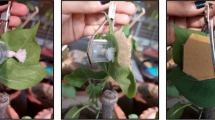Abstract
Screenhouse experiments were conducted under free-choice conditions to determine the mechanism of resistance operating in cotton against whitefly, Bemisia tabaci (Gennadius) (Homoptera: Aleyrodidae). Twelve cotton genotypes belonging to Gossypium hirsutum and G. arboreum were assessed for oviposition preference by whitefly. The trichome density and length, distance from lower leaf surface to nearest vascular bundles, leaf lamina thickness and compactness of vascular bundles were estimated for each genotype and correlations with number of eggs laid were determined. The genotypes RS2098, CNH911, and PA183 were non-preferred for oviposition and exhibited an antixenosis mechanism of resistance. NHH44, LK861, Supriya, RS2013 and LD694 were categorized as moderately resistant while IS-376/4/1/20/72 and F846 were categorized as susceptible. Greater leaf lamina thickness and more compact vascular bundles were correlated with egg laying by whitefly.
Similar content being viewed by others
References
Ashraf, M., Zafar, Z. U., McNeilly, T., & Veltkamp, C. J. (1999). Some morpho-anatomical characteristics of cotton (Gossypium hirsutum L.) in relation to resistance to cotton leaf curl virus (CLCuV). Angewandte Botanik, 73(3–4), 76–82.
Blua, M. J., Yoshida, H. A., & Toscano, N. C. (1995). Oviposition preference of two Bemisia species (Homoptera: Aleyrodidae). Environmental Entomology, 24, 88–93.
Boica, A. L., Jr., Campos, Z. R., Lourencao, A. L., & Campos, A. R. (2007). Adult attractiveness and oviposition preference of Bemisia tabaci (Genn.) (Homoptera: Aleyrodidae) B-biotypes in cotton genotypes. Scientia Agricola, 64, 147–151.
Butter, N. S., & Vir, B. K. (1989). Morphological basis of resistance in cotton to the whitefly, Bemisia tabaci. Phytoparasitica, 17, 251–261.
Chu, C. C., Cohen, A. C., Natwick, E. T., Simmons, G. S., & Henneberry, T. J. (1999). Silverleaf whitefly colonization and leaf shape and vascular bundles relationships in cotton. In P. Dugger & D. Richter (Eds.), Proceedings of Beltwide Cotton Conference, Vol 2 (pp. 909-910). Orlando, Florida, USA.
Chu, C. C., Freeman, T. P., Buckner, J. S., Henneberry, T. J., Nelson, D. R., & Natwick, E. T. (2001). Susceptibility of upland cotton cultivars to Bemisia tabaci biotype B (Homoptera: Aleyrodidae) in relation to leaf age and trichome density. Annals of the Entomological Society of America, 94, 743–749.
Chu, C. C., Henneberry, T. J., & Cohen, A. C. (1995). Bemisia argentifolii (Homoptera: Aleyrodidae): host preference and factors affecting oviposition and feeding site preference. Environmental Entomology, 24, 354–360.
Chu, C. C., Natwick, E. T., & Henneberry, T. J. (2002). Bemisia tabaci (Homoptera: Aleyrodidae) biotypes B colonization on okra and normal leaf upland cotton strains and cultivars. Journal of Economic Entomology, 95, 733–738.
Dhawan, A. K. (2004). Insect resistance in cotton: Achievements and challenges. In G. S. Dhaliwal & R. Singh (Eds.), Host plant resistance to insects; concepts and applications (pp. 263–314). New Delhi, India: Panima Publishing Corporation.
Finch, S., & Collier, R. H. (2000). Host-plant selection by insects—a theory based on ‘appropriate/inappropriate landings’ by pest insect of cruciferous plants. Entomolgia Experimentalis et Applicata, 96, 91–102.
Jindal, V., & Dhaliwal, G. S. (2009). Elucidating resistance of cotton genotypes to whitefly, Bemisia tabaci, by population buildup studies. Phytoparasitica, 37, 137–145.
Jindal, V., Dhaliwal, G. S., & Dhawan, A. K. (2007). Mechanisms of resistance in cotton to whitefly Bemisia tabaci (Homoptera: Aleyrodidae): antibiosis. International Journal of Tropical Insect Science, 27, 216–222.
Jindal, V., Dhaliwal, G. S., Dhawan, A. K., & Dilawari, V. K. (2009). Mechanisms of resistance in cotton to whitefly (Bemisia tabaci): Tolerance. Phytoparasitica, 37, 249–254.
Johansen, D. A. (1940). Plant microtechniques. New York, NY: McGraw-Hill Book Company Inc.
Meagher, R. L., Jr., Smith, C. W., & Smith, W. J. (1997). Preference of Gossypium genotypes to Bemisia argentifolii (Homoptera: Aleyrodidae). Journal of Economic Entomology, 90, 1046–1052.
Mound, L. A. (1965). Effect of leaf hairs on cotton whitefly population in the Sudan Gezira. Empire Cotton Growing Review, 42, 33–40.
Painter, R. H. (1951). Insect resistance in crop plants. New York, NY: The MacMillan Co.
Sass, E. F. (1959). Botanical microtechniques (3rd ed.). London, UK: Constable and Co. Ltd.
Toscano, L. C., dos Santos, T. M., & Boica, A. L., Jr. (2003). Preference of Bemisia tabaci biotype B oviposition in cotton cultivars. Pesquisa Agropecuaria Brasileira, 38, 155–160.
Van Lenteren, J. C., & Noldus, L. P. J. J. (1990). Whitefly–plant relationships: Behavioural and ecological aspects. In D. Gerling (Ed.), Whiteflies: Their bionomics, pest status and management (pp. 47–89). Wimborne, UK: Intercept Ltd.
Author information
Authors and Affiliations
Corresponding author
Rights and permissions
About this article
Cite this article
Jindal, V., Dhaliwal, G.S. Mechanisms of resistance in cotton to whitefly (Bemisia tabaci): antixenosis. Phytoparasitica 39, 129–136 (2011). https://doi.org/10.1007/s12600-011-0144-x
Received:
Accepted:
Published:
Issue Date:
DOI: https://doi.org/10.1007/s12600-011-0144-x




